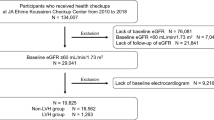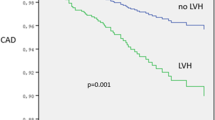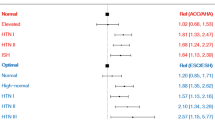Abstract
Whether high–normal blood pressure (BP) is a predictor of new-onset electrocardiographic (ECG)-left ventricular hypertrophy (LVH) is not known. A total of 4112 subjects who underwent physical examinations were enrolled in this study. BP was measured on entry. Standard 12-lead ECG was recorded at initial evaluation and 3 years later. BP categories were defined on the basis of the 2013 European Society of Hypertension/European Society of Cardiology guidelines. Of the 4112 subjects, 133 developed ECG-LVH 3 years later. Crude cumulative prevalence rates of new-onset ECG-LVH were 2.0% for the optimal BP group, 3.2% for the normal BP group, 5.1% for the high–normal BP group and 5.0% for the hypertension group. After adjustment for age, gender, body mass index, smoking, low-density lipoprotein cholesterol, log-transformed high-density lipoprotein cholesterol, log-transformed triglycerides, estimated glomerular filtration rate, haemoglobin A1c, haemoglobin, uric acid and antihypertensive medication use, compared with the optimal BP group, the odds ratios of new-onset ECG-LVH for the normal BP, high–normal BP and hypertension groups were 1.52 (95% confidence interval (CI): 0.93–2.49, P=0.094), 2.38 (95% CI: 1.40–4.03, P=0.001) and 2.44 (95% CI: 1.43–4.18, P=0.001), respectively. Even high–normal BP was significantly associated with the presence of new-onset ECG-LVH.
This is a preview of subscription content, access via your institution
Access options
Subscribe to this journal
Receive 12 digital issues and online access to articles
$119.00 per year
only $9.92 per issue
Buy this article
- Purchase on Springer Link
- Instant access to full article PDF
Prices may be subject to local taxes which are calculated during checkout

Similar content being viewed by others
References
Wilson PW, D'Agostino RB, Levy D, Belanger AM, Silbershatz H, Kannel WB . Prediction of coronary heart disease using risk factor categories. Circulation 1998; 97: 1837–1847.
Chobanian AV, Bakris GL, Black HR, Cushman WC, Green LA, Izzo Jr JL et al Joint National Committee on Prevention, Detection, Evaluation, and Treatment of High Blood Pressure. National Heart, Lung, and Blood Institute; National High Blood Pressure Education Program Coordinating Committee. Seventh report of the Joint National Committee on Prevention, Detection, Evaluation, and Treatment of High Blood Pressure. Hypertension 2003; 42: 1206–1252.
Mancia G, Fagard R, Narkiewicz K, Redón J, Zanchetti A, Böhm M et al. 2013 ESH/ESC Guidelines for the management of arterial hypertension: the Task Force for the management of arterial hypertension of the European Society of Hypertension (ESH) and of the European Society of Cardiology (ESC). J Hypertens 2013; 31: 1281–1357.
Vasan RS, Larson MG, Leip EP, Kannel WB, Levy D . Assessment of frequency of progression to hypertension in non-hypertensive participants in the Framingham Heart Study: a cohort study. Lancet 2001; 358: 1682–1686.
Vasan RS, Beiser A, Seshadri S, Larson MG, Kannel WB, D'Agostino RB et al. Residual lifetime risk for developing hypertension in middle-aged women and men: the Framingham Heart Study. JAMA 2002; 287: 1003–1010.
Hayashi T, Tsumura K, Suematsu C, Endo G, Fujii S, Okada K . High normal blood pressure, hypertension, and the risk of type 2 diabetes in Japanese men. The Osaka Health Survey. Diabetes Care 1999; 22: 1683–1687.
Vasan RS, Larson MG, Leip EP, Evans JC, O'Donnell CJ, Kannel WB et al. Impact of high-normal blood pressure on the risk of cardiovascular disease. N Engl J Med 2001; 345: 1291–1297.
Kokubo Y, Kamide K, Okamura T, Watanabe M, Higashiyama A, Kawanishi K et al. Impact of high-normal blood pressure on the risk of cardiovascular disease in a Japanese urban cohort: the Suita study. Hypertension 2008; 52: 652–659.
Kondo T, Osugi S, Shimokata K, Honjo H, Okumura N, Matsudaira K et al. Cardiovascular events increased at normal and high-normal blood pressure in young and middle-aged Japanese male smokers but not in nonsmokers. J Hypertens 2013; 31: 263–270.
Hadaegh F, Mohebi R, Khalili D, Hasheminia M, Sheikholeslami F, Azizi F . High normal blood pressure is an independent risk factor for cardiovascular disease among middle-aged but not in elderly populations: 9-year results of a population-based study. J Hum Hypertens 2013; 27: 18–23.
Conen D, Tedrow UB, Koplan BA, Glynn RJ, Buring JE, Albert CM . Influence of systolic and diastolic blood pressure on the risk of incident atrial fibrillation in women. Circulation 2009; 119: 2146–2152.
Grundvold I, Skretteberg PT, Liestøl K, Erikssen G, Kjeldsen SE, Arnesen H et al. Upper normal blood pressures predict incident atrial fibrillation in healthy middle-aged men: a 35-year follow-up study. Hypertension 2012; 59: 198–204.
Kannel WB, Gordon T, Offutt D . Left ventricular hypertrophy by electrocardiogram. Prevalence, incidence, and mortality in the Framingham study. Ann Intern Med 1969; 71: 89–105.
Vakili BA, Okin PM, Devereux RB . Prognostic implications of left ventricular hypertrophy. Am Heart J 2001; 141: 334–341.
Levy D, Labib SB, Anderson KM, Christiansen JC, Kannel WB, Castelli WP . Determinants of sensitivity and specificity of electrocardiographic criteria for left ventricular hypertrophy. Circulation 1990; 81: 815–820.
Pewsner D, Jüni P, Egger M, Battaglia M, Sundström J, Bachmann LM . Accuracy of electrocardiography in diagnosis of left ventricular hypertrophy in arterial hypertension: systematic review. BMJ 2007; 335: 711.
Cuspidi C, Rescaldani M, Sala C, Negri F, Grassi G, Mancia G . Prevalence of electrocardiographic left ventricular hypertrophy in human hypertension: an updated review. J Hypertens 2012; 30: 2066–2073.
Matsuo S, Imai E, Horio M, Yasuda Y, Tomita K, Nitta K et al Collaborators developing the Japanese equation for estimated GFR. Revised equations for estimated GFR from serum creatinine in Japan. Am J Kidney Dis 2009; 53: 982–992.
Five-year findings of the Hypertension Detection and Follow-up Program. Prevention and reversal of left ventricular hypertrophy with antihypertensive drug therapy. Hypertension Detection and Follow-up Program Cooperative Group. Hypertension 1985; 7: 105–112.
Devereux RB, Palmieri V, Liu JE, Wachtell K, Bella JN, Boman K et al. Progressive hypertrophy regression with sustained pressure reduction in hypertension: the Losartan Intervention For Endpoint Reduction study. J Hypertens 2002; 20: 1445–1450.
Okin PM, Devereux RB, Jern S, Kjeldsen SE, Julius S, Nieminen MS et al Losartan Intervention for Endpoint reduction in hypertension Study Investigations. Regression of electrocardiographic left ventricular hypertrophy by losartan versus atenolol: the Losartan Intervention for Endpoint reduction in Hypertension (LIFE) Study. Circulation 2003; 108: 684–690.
Schneider MP, Klingbeil AU, Delles C, Ludwig M, Kolloch RE, Krekler M et al. Effect of irbesartan versus atenolol on left ventricular mass and voltage: results of the CardioVascular Irbesartan Project. Hypertension 2004; 44: 61–66.
Barrios V, Calderón A, Escobar C, Barrios S, Navarro-Cid J, González-Pedel V et al. Electrocardiographic left ventricular hypertrophy regression induced by an angiotensin receptor blocker-based regimen in daily clinical practice: the SARA study. J Hypertens 2007; 25: 1967–1973.
Viazzi F, Parodi D, Leoncini G, Parodi A, Falqui V, Ratto E et al. Serum uric acid and target organ damage in primary hypertension. Hypertension 2005; 45: 991–996.
Iwashima Y, Horio T, Kamide K, Rakugi H, Ogihara T, Kawano Y . Uric acid, left ventricular mass index, and risk of cardiovascular disease in essential hypertension. Hypertension 2006; 47: 195–202.
Johnson RJ, Feig DI, Herrera-Acosta J, Kang DH . Resurrection of uric acid as a causal risk factor in essential hypertension. Hypertension 2005; 45: 18–20.
Syamala S, Li J, Shankar A . Association between serum uric acid and prehypertension among US adults. J Hypertens 2007; 25: 1583–1589.
da Costa W, Riera AR, Costa Fde A, Bombig MT, de Paola AA, Carvalho AC et al. Correlation of electrocardiographic left ventricular hypertrophy criteria with left ventricular mass by echocardiogram in obese hypertensive patients. J Electrocardiol 2008; 41: 724–729.
Author information
Authors and Affiliations
Corresponding author
Ethics declarations
Competing interests
The authors declare no conflict of interest.
Rights and permissions
About this article
Cite this article
Ueda, H., Miyawaki, M. & Hiraoka, H. High–normal blood pressure is associated with new-onset electrocardiographic left ventricular hypertrophy. J Hum Hypertens 29, 9–13 (2015). https://doi.org/10.1038/jhh.2014.21
Received:
Revised:
Accepted:
Published:
Issue Date:
DOI: https://doi.org/10.1038/jhh.2014.21



